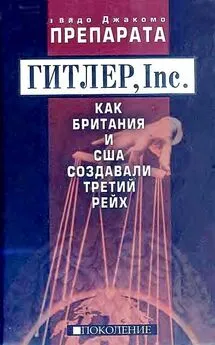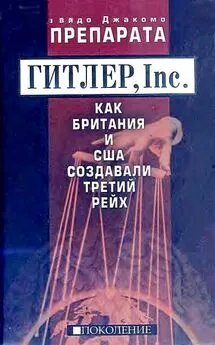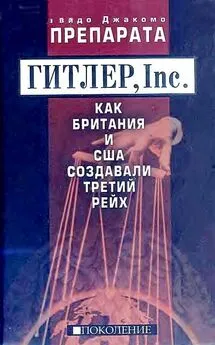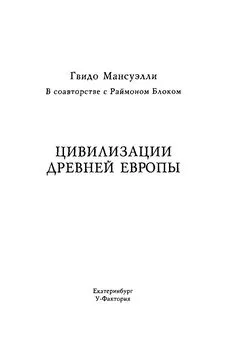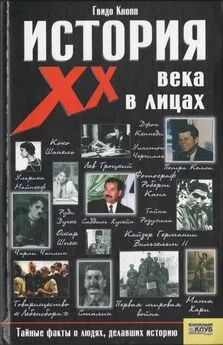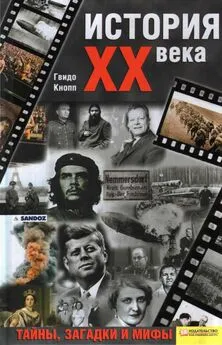Гвидо Препарата -
- Название:
- Автор:
- Жанр:
- Издательство:неизвестно
- Год:неизвестен
- ISBN:нет данных
- Рейтинг:
- Избранное:Добавить в избранное
-
Отзывы:
-
Ваша оценка:
Гвидо Препарата - краткое содержание
Последовавшее за поражением нацизма воцарение Pax Americana («Мир американский») имело, по мнению Г. Препараты, подготовленную десятилетиями почву, ставило конкретные цели и очень дорого обошлось Европе. Нацисты ни при каких обстоятельствах не могли стать порождением слепого случая. Писатель показывает, что на протяжении 15 лет (1919-33) англо-саксонская элита активно вмешивалась в германскую политику, имея осознанное намерение создать движение, каковое можно было бы впоследствии использовать как пешку в большой геополитической интриге.
История, рассказанная в этой книге, — это, по сути, история Британской империи, которая, напуганная ростом могущества юного Германского рейха, начала разрабатывать и приводить в исполнение секретный план стратегического окружения Евразийского массива. Главная цель этого масштабного окружения — уничтожить то, что сможет угрожать самому существованию Британской империи в наступающем столетии. Придя к этому пониманию, Британия начала кампанию, имевшую целью расчленение Евразии...
Перевод с английского А. Анваера
- читать онлайн бесплатно полную версию (весь текст целиком)
Интервал:
Закладка:
p. 115.
50. Hitler, Secret Conversations, p. 350.
51. Edward Norman Peterson, Hjalmar Schacht: For and Against Hitler
(Boston: Christopher Publishing House, 1954), p. 149; emphasis added.
52. Poole, German Financial Policies, p. 29.
53. R.J. Overy, War and Economy in tfie Third Reich (Oxford: Clarendon
Press, 1994), p. 38.
54. Otto Nathan, Nazi War Finance and Banking (NBER Paper No. 20,
1944), p. 43.
55. Samuel Lurie, Private Investment in a Controlled Economy (New York:
Columbia University Press, 1947), p. 15.
56. Ibid., pp. 58-9.
57. Thamer, Terzo Reich, p. 414.
58. Avraham Barkai, Nazi Economics. Ideology, Theory and Policy (New Haven:
Yale University Press, 1990), p. 165.
59. Hitler, Secret Conversations, p. 372.
60. Poole, German Financial Policies, p. 111.
61. Lurie, Private Investment, p. 36, and Barkai, Nazi Economics, p. 255.
62. Marczewski, Politique monetaire, p. 88.
63. Poole, German Financial Policies, pp. 118-20.
64. Lurie, Private Investment, p. 158.
65. Ibid., p. 59.
66. Ibid., pp. 57-8, 154.
67. Barkai, Nazi Economics, p. 158.
68. Bank of England, OV 34/9, from two memoranda, respectively, by
G. H. S. Pinsent, 6 December 1938 (p. 79), and С. F. Cobbold, 24 August 1939 (p. 231).
69. О very, War and Economy, p. 42.
70. David Schoenbaum, Hitler's Social Revolution. Class and Status in Nazi
Germany, 1933-1939 (New York: W. W. Norton & Company, Inc., 1980 [1966]), pp. 145-8.
71. Schacht, Autobiography, p. 317.
72. Fischer, Nazi Germany, p. 377.
73. Stephen Roberts, The House That Hitler Built (New York: Harper & Brothers Publishers, 1938), p. 172.
74. H. W. Arndt, The Economic Lessons of the Nineteen Thirties (London:
Oxford University Press, 1944), pp. 187-8.
75. Bruno Bettelheim, Leconomie allemande sous le nazisme: un aspect
de la decadence du capitalisme (Paris: Librairie Marcel Riviere et Cie., 1946), p. 180.
i
76. Muhlen, Schacht, pp. 120-35.
77. Weitz, Hitler's Banker, p. 206.
78. Neil Forbes, Doing Business With the Nazis. Britain's Economic and
Financial Relations With Germany, 1931-1939 (London: Frank Cass, 2000), p. 97.
79. Ibid., p. 107.
80. Cleona Lewis, Nazi Europe and World Trade (Washington DC: Brookings
Institution, 1941), p. 16.
81. Forbes, Doing Business, p. 181.
82. Английский банк, Документ 34/201, стр. 10, меморандум, датированный 14 октября 1934 года, в котором говорится о моратории по ценным бумагам, выданным по выделенным до июля 1931 года кредитным линиям (выделено мною.— Г. П.), что можно расценить, как обеспечение для началa нового цикла заимствований германским импортерам через такие краткосрочные ценные бумаги, которые возобновлялись тотчас после их оплаты.
83. John Gimther, Inside Europe (New York: Harper & Brothers, 1938),
p. 99.
84. Forbes, Doing Business, pp. 113, 116.
85. Ibid., pp. 173, 174.
86. Muhlen, Schacht, p. 35.
87. Martin Gilbert, The Roots of Appeasement (New York: New American
Library, 1966), p. 155.
88. Henry Clay, Lord Norman (London: Macmillan 8c Co., 1957),
pp. 318-22.
89. Dorothy Woodman, Hitler Rearms. An Exposure of Germany's War Plans
(London: John Lane; Bodley Head Limited, 1934), p. 201.
90. John Hargrave, Montagu Norman (New York: Greystone Press, 1942),
p. 218.
91. Ernst Hanfstaengl, Hitler: The Missing Years (New York: Arcade Publishing, 1994 [1957]), p. 204.
92. Anthony Sutton, Wall Street and the Rise of Hitler (Sudbury: Suffolk:
Bloomfield Books, 1976), pp. 15-16.
93. William Dodd, Ambassador Dodd's Diary, 1933-1938 (New York:
Harcourt, Brace and Company, 1941), pp. 166, 170, 176.
94. Bettelheim, Leconomie allemande, p. 78.
95. Charles Higham, Trading With the Enemy: An Expose of the Nazi-American Money Plot, 1933-1949 (New York: Delacorte Press, 1983), p. xvi.
96. Andrej Gromyko, Uespansione internazionale del capitate, storia e
attualita (Roma: Editori Riuniti, 1985 [1982]), p. 151.
97. Padfield, Himmler, p. 206.
98. Schacht, Autobiography, p. 370.
99. Ibid. pp. 366ff.
100. Padfield, Himmler, p. 208.
101. Hitler, Secret Conversations, pp. 514-15.
102. Weitz, Hitler's Banker, p. 240.
103. Schacht, Autobiography, pp. 383-4.
104. Ron Chernow, The Warburgs. The Twentieth-Century Odyssey of a
RemarkableJewish Family (New York: Random House, 1993), pp. 480-5.
105. Gilbert, Appeasement, pp. 138-50.
106. Quigley, Tragedy, p. 581.
107. Gunther, Inside Europe, p. 278.
108. Carroll Quigley, The Anglo-American Establishment. From RJiodes to
Cliveden (San Pedro, CA: GSG 8c Associates Publishers, 1981),
pp. 227-8.
109. Quigley, Tragedy, p. 653.
110. Ibid., p. 582.
111. Gilbert, Appeasement, pp. 79-80.
112. Ibid., p. 120.
113. Louis Kilzer, ChurchilVs Deception. The Dark Secret that Destroyed Germany
(New York: Simon & Schuster, 1994), p. 117.
114. Fran^ois-Poncet, Fateful Years, pp. 152-3.
115. Цитата приведена в книге Клемента Лейбовича (Clement Leibo-
witz) и Алвина Финкеля (Alvin Finkel): In Our Time. The Chamberlain-Hitler Collusion (New York: Monthly Review Press, 1998), p. 23.
116. Ivan Maisky, Who Helped Hitler? (London: Hutchinson, 1964 [1962]),
p. 55.
117. David Irving, ChurchilVs War: Vol. I, The Struggle for Power (Bullsbrook,
Australia: Veritas Publishing Company, 1987), pp. 39-40.
118. Charles Higham, The Duchess of Windsor. The Secret Life (New York:
McGraw&Hill, 1988), p. 109.
119. Peter Alien, The Windsor Secret. New Revelations of the Nazi connections
New York: Stein 8c Day Publishers, 1984), p. 34.
120. Paul Schmidt, Da Versaglia a Norimberga (Roma: L'arnia, 1951),
pp. 271-80.
121. Benoist-Mechin, Armee allemande, Vol. 3, p. 263.
122. Schmidt, Da Versaglia, p. 291.
123. Benoist-Mechin, Armee allemande, Vol. 3, p. 267.
124. Hanfstaengl, Missing Years, p. 228.
125. Higham, Duchess of Windsor, p. 117.
126. Schmidt, Da Versaglia, p. 293.
127. Higham, Duchess of Windsor, p. 130.
128. Alien, Windsor Secret, p. 68.
129. Maisky, Who Helped Hitler?, p. 57.
130. Hitler, Secret Conversations, pp. 556-7.
131. Hajo Holborn, A History of Modern Germany (Princeton: Princeton
University Press, 1969), p. 769.
132. Alien, Windsor Secret, p. 69.
133. Benoist-Mechin, Armee allemande, Vol. 3, pp. 286-95.
134. Irving, ChurchilVs War, pp. 54-5.
135. Alfred Smith, Rudolf Hess and Germany's Reluctant War, 1939-1941
(Sussex: Book Guild Ltd., 2001), p. 61.
136. George Lentin, Lloyd George and the Lost Peace. From Versailles to Hitler,
1919-1940 (Basingstoke: Palgrave Macmillan, 2001), p. 103.
137. Ibid., p. 99.
138. Lord Beaverbrook, The Abdication of King Edward VIII (New York:
Atheneum, 1966), p. 63.
139. Higham, Duchess of Windsor, p. 188.
140. Alien, Windsor Secret, p. 97.
141. Greg King, The Duchess of Windsor. The Uncommon Life ofWallis Simpson
(New York: Citadel Press, 1999), p. 280.
142. Quigley, Tragedy, p. 583.
143. Ibid., p. 777.
144. Benoist-Mechin, Armee allemande, Vol. 5, p. 307.
145. Ibid., Vol. 5, pp. 340-5.
146. Quigley, Anglo-American Establishment, pp. 286-8.
147. Quigley, Tragedy, p. 631.
148. Ibid., p. 627.
149. Ibid., p. 633.
150. Leibovitz and Finkel, In Our Time, p. 144.
151. Ibid., p. 182.
152. Alien, Windsor Secret, p. 253.
153. Quigley, Tragedy, pp. 642-3.
154. Ibid., p. 646.
155. Ibid., p. 648.
156. Benoist-Mechin, Armee allemande, Vol. 6, p. 179.
157. David Irving, The War Path: Hitler's Germany, 1933-1939 (London:
Michael Joseph, 1978), p. 193.
158. Leibovitz and Finkel, In Our Time, p. 208.
159. Ibid., pp. 256, 232.
160. Irving, ChuchilVs War, pp. 167-8.
161. Kilzer, Churchill's Deception, p. 124.
162. Simon S. Montefiore, Stalin, the Court of the Red Tsar (New York: Alfred
Knopf, 2004), p. 307.
163. Angiolo Forzoni, Rublo. Storia civile e monetaria delle Russia da Ivan a
Stalin (Roma: Valerio Levi Editore, 1991), p. 533.
164. Irving, ChuchilVs War, p. 61.
165. Ibid., p. 162.
166. Edward Radzinsky, Stalin (New York: Doubleday, 1996), p. 323.
(Э. С. Радзинский «Сталин: жизнь и смертиь», изд-во «Вагриус»).
167. Montefiore, Stalin, p. 222.
168. Benoist-Mechin, Armee allemande, Vol. 4, pp. 210-70.
169. W. G. Krivitsky, In Stalin's Secret Service (New York: Enigma Books, 2000
[1941]). pp. 205-8.
170. Ibid., p. 12.
171. Edward E. Ericson, Feeding the German Eagle. Soviet Economic Aid to Nazi
Germany, 1933-1941 (Westport, CA: Praeger, 1999), p. 182, and Tha-mer, Terzo Reich, p. 793.
172. David Irving, Hitler's War (New York: Avon Books, 1990), p. 360.
173. Quigley, Anglo-American Establishment, p. 298.
174. Maisky, Who Helped Hitler?, p. 171.
175. Montefiore, Stalin, p. 312.
176. Junger, Marble Cliffs, 1947.
177. Исследованию вопроса о мавританцах Юнгера посвящена книга
Jiilien Hervier Deux indivdus cintre Vhistoire: Pierre Drieu la Rochelle; Ernst Junger (Paris: Editions Klinksieck, 1978), p. 191.
178. Benoist-Mechin, Armee allemande, Vol. 3, p. 23.
179. Irving, ChuchilVs War, p. 193.
180. Smith, Rudolf Hess, p. 109.
181. Quigley, Tragedy, p. 667.
182. Cornwell, Hitler's Pope, p. 236.
183. Ibid., p. 238.
184. Smith, Rudolf Hess, p. 138.
185. Leibovitz and Finkel, In Our Time, p. 231.
186. Higham, Duchess of Windsor, p. 276.
187. Kilzer, Churchill's Deception, p. 231.
188. Ibid., p. 229.
189. Higham, Duchess of Windsor, p. 265.
190. Alien, Windsor Secret, p. 200.
191. Irving, Churchill's War, p. 379; Irving, Hitler's War, p. 306.
192. Irving, Churchill's War, p. 376.
193. Alien, Windsor Secret, pp. 224-33, and Smith, Rudolf Hess, p. 245.
194. Michael Veranov (Ed.), Tlie Mammoth Book of the Third Reich at War
(New York: Carroll 8c Graf Publishers Inc. 1997), p. 141.
195. Smith, Rudolf Hess, p. 55.
196. Irving, ChurchilVs War, p. 193.
197. Quigley, Tragedy, p. 715.
198. Irving, ChurchilVs War, pp. 483-9.
199. Quigley, Tragedy, p. 720.
200. Kilzer, ChurchilVs Deception, p. 270.
201. Irving, Hitler's War, p. 358.
202. Hugh Thomas, The Murder of Rudolf Hess (New York: Harper 8c Row
Publishers, 1979).
203. Richard Deacon, A History of the British Secret Service (London:
Frederick Muller, 1969), p. 319.
204. Alien, Windsor Secret, p. 261.
205. Gordon Thomas, Journey into Madness. The True story of Secret CIA Mind
Control and Medical Abuse (New York: Bantam Books, 1989), pp. 152-3.
206. International Military Tribunal, Trial of the Major War Criminals,
14 November 1945-1 October 1946, Vol. XXII (Nuremberg, 1948), pp. 368-72.
207. John K. Lattimer, Hitler & the Nazi Leaders. A Unique Insight into Evil
(New York: Hippocene Books, Inc., 2001), pp. 109-17.
Читать дальшеИнтервал:
Закладка:
